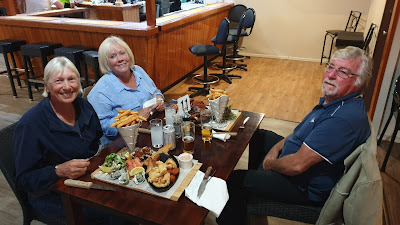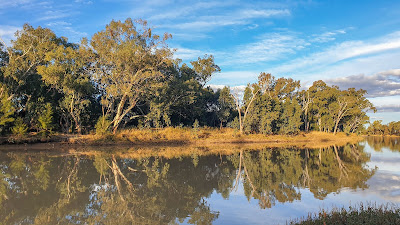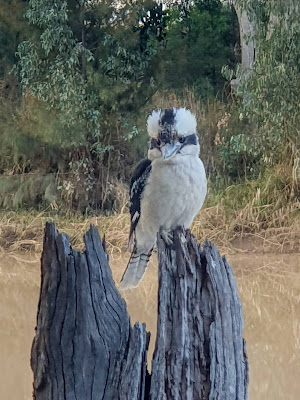Covid-19 has been affecting all of us in many ways during 2020, so what it has meant for us travel wise is cancelling all overseas travel bookings, trying to get as many $’s back as possible, largely successful thankfully and to abandon unfortunately our son’s 40th birthday celebration in London.
Like many of us we went into Queensland’s (Qld) form of lockdown which meant for a few months staying near home etc etc until finally in June we were allowed to roam within the State whilst maintaining social distancing.
Time for a road trip!
Below are 2 examples of the same route we took, the first showing our travels in context within Australia and then another showing greater specificity within Queensland.
 |
| Route into western Qld relative to whole country |
 |
| Various locations visited within western Qld |
Due to Covid based restrictions, we could now only travel within the Queensland State borders with entry across borders banned and blocked.
Good friends Julie and Pete were also keen to head west into the bush, so after thinking about a very rough itinerary to accomodate a date they needed to be back home by, we packed, hooked up the van and departed.
One of our shared goals in this trip was to make sure we visited pubs, bakeries, supermarkets etc within most locations and spend some $’s as our way of supporting and helping more remote communities hit hard by a lack of tourists during harsher Covid lockdowns.
We had agreed a meeting destination near Dalby which allowed us to visit my sister for a few nights before spending some nights in the garden city of Toowoomba, a destination we usually drive through, so this trip was a good opportunity to explore it a little more. Was nice to wander around the streets admiring the houses and indeed gardens for 2 days before reaching our meeting location.
Lake Broadwater is located about 32 kms south west from Dalby, somewhere we stayed in Dec 2017 and experienced this…
We weren’t expecting the same event to happen again, but its a nice place to wait for our friends to arrive because you simply camp where you like overlooking the lake and normally, hot showers are available, along with toilet facilities, but Covid had meant the closing of the showers.
 |
| Set up Lake Broadwater |
Julie and Pete arrived and after a few very chilly nights of 2-3 deg C and foggy mornings providing some stunning scenes over the water, we started our travels west, next stop the Nindigully Pub about 3 hrs drive away.
 |
| Chilly and foggy sunrise over the lake |
Julie & Pete had chosen this destination, having briefly visited the previous year, but this time we would stay a few nights, camping in the scrub near the Moonie River and the pub itself, along with 15-20 other travellers doing the same thing.
The Nindigully Pub is Queensland’s oldest pub still in its original condition, its license issued in 1864 after operating as shearer’s accommodation for the cattle Station of the same name. From the late 1800s the Nindigilly Pub was also a Cobb and Co coach change over station.
 |
| Nindigully Pub |
It is a big rambling pub with a huge external beer garden and fire pit to match, and was very busy with most people maintaining good social distancing. Along with a gold coin donation for hot showers, they also offer some interesting staples like the the massive road train burger with a 1.2 kg meat patty in it for 1-4 people.
 |
| Beer garden at Nindigully Pub |
| Roadtrain burger at Nindigully Pub (Source: photo via Google) |
Next stop was Charlotte Plains Station, 54 km east of Cunnamulla and after a 15 km drive from its front gate we reached the homestead and obtained directions to a choice of camping areas. This is a sheep and cattle station of ~ 70,000 acres (31,000 hectares) or about half the size of Singapore.
We stayed near the shearers quarters and 100+ year old shearing shed which is still in use. Others already camping nearby quickly gave us a few tips re showers, camp kitchen and other facilities. Scattered around the area were old chairs which could be used around the large fire area, still smouldering from the night before.
 |
| Camping area on Charlotte Plains Station |
Eventually the owner of the property, Robyn, turned up to make sure we were settling in okay and asked if we wanted to do a tag along tour of the property next day, “sure” we all said.
Robyn, a lady in her early 70’s is a person we learnt has experienced a lot of living out here for many years running the property, now with the help of Tizz, a laconic bloke and former jockey for Robyn’s mother… more on him soon.
 |
| 100+ year old shearing sheds still being used on Charlotte Plains |
A family of four arrived and settled into some of the shearers quarters for a 3 day stay here and later that night Tizz returned in his beat up 4WD with chain saw and a beer in hand to cut some large logs into manageable sizes for the fire.
He threw 3 large gidgee timber logs onto the still smouldering fire pit, before opening yet another can of beer. Tizz was an interesting bloke to talk to about life on a large station, the impacts of drought, trying to deal with wild domestic dogs, massive fencing tasks and a myriad of other things to be done.
Eventually the gidgee logs burst into flame and the heat this very hard wood provided was welcomed as the sun set and temperatures plunged towards low single digits again overnight.
 |
| Enjoying a great camp fire with others under the stars on Charlotte Plains Station |
Our motley group of campers, sitting around the fire, enjoyed a pleasant night sharing stories and asking Tizz lots more questions before he finally climbed into his old car and rattled off down the dirt track back towards the homestead, dust trailing behind him lit by the moon.
Next morning we met Robyn at the artesian bore and her tour of the station was indeed interesting as she weaved in stories of her own life here as a way explaining life and going ons over time. Sadly there are very few members of her own family willing to keep the station going, the most interested being an 11 year old grandson. It seemed that Robyn was trying to keep a dream alive for as long as possible.
During the tour we visited the tiny ‘Jack’s shack’ where Jack had lived alone for many years working on the property in its early and more successful times… he must have been a very tough and resourceful person.
 |
| Some of the remains around Jack's shack |
Near Jack’s shack were the decaying remains of 2 camel caravan trailers, owned by another person Robyn had taken in and who ran camel tours around the property for years. Little was known about the cameleer but eventually a ‘do gooder’ got in his ear about not being paid enough.
 |
| What remains of the camaleer's caravans |
He went to Centrelink, then realised he may be deported because it turned out he was an immigrant from years earlier and without a passport or residency status. Unfortunately it scared him a lot he might be deported and decided to commit suicide.
Now his camels are free to roam Charlotte Plains.
During our tour we also learnt about the importance of artesian water to the station for supporting its own and neighbouring properties stock. This regulated but constant flow of very warm water also provides the property with tourism opportunities and the future development of a wetland area for local wildlife.
 |
| Constant artesian water flowing into the channel |
The time had come for us to enjoy the benefits of this warm water as we drove out to the bore pouring a constant stream of water into a channel. Charlotte Plains had innovatively installed 8 bathtubs and plumbed artesian water to each and this was the result… beautiful!
 |
| We enjoyed soaking in the warm water |
 |
| Julie & Pete also enjoying their baths |
Further west, Thargamindah was a surprising town with many modern facilities, especially considering its population of ~300 people. We stayed in a large and very well built caravan park, there were many new government/council buildings and a very well constructed river walk for tourists to enjoy.
 |
| Views from the river walk in Thargamindah |
We had one further destination to reach out west and 142 kms from Thargamindah before turning back east again and this was when we set up camp next to the Wilson River and not very far from the Noccundra Hotel.
 |
| Driving further west whilst avoiding a few obstacles |
This hotel also happens to be about 300kms away from a historic destination in western Qld called the ‘Dig Tree’ where Burke and Wills, the first people to cross Australia from south to north but died of starvation at this location during their return journey.
 |
| Camping next to the Wilson River |
The Noccundra Hotel has been serving beer here since 1882 and is built out of locally quarried sandstone and carted to this location using camels. It is a very sturdy old building and the people running this pub were extremely diligent in making sure people were socially distancing, the correct forms we completed and hands were cleaned. They even washed any cash tourists used to pay for their meals or beers.
 |
| The very old Noccundra Hotel |
One downside of our free camp was the sudden inclusion of hundreds of small and very intrusive meat flies trying to get into ears and noses, congregating around our eyes and generally being a nuisance.
After watching the sun setting on the river, we walked the 500m to the pub to have dinner before returning and enjoying a great sleep under the stars and not a sound to be heard.
 |
| Sunset on the Wilson River |
The flies soon re-arrived as the sun rose making the trees on the opposite side of the river almost glow, so we made the decision to head off towards Quilpie, stopping at Eromanga on the way.
 |
| Sunrise on the Wilson River |
Eromanga is home to Cooper, Australia’s largest fossil remains of a dinosaur which was about 12 metres long and weighed about 7 tonnes. He was a titanosaur and roamed this area at least 65 million years ago.
 |
| Arriving into Eromanga |
There is a museum located in a large purpose built ‘shed’ at Eromanga where the results of their annual 2 week digs in the area are stored, and a small group of very dedicated and enthusiastic specialists, slowly uncover the fossil remains of dinosaurs and also much younger megafauna which also called this area home.
Some of the megafauna included diprotodons which stood 3 metres high and weighed between 2,000-3,000kg, or both giant wombats weighing 200kgs and giant kangaroos.
 |
| Replicas of fossil remains of 'Cooper' |
Quilpie was about 100kms from Eromanga and thankfully we reached the local bakery for a late lunch just before it closed for the day. After setting up in one of the caravan parks for a few days stay, we drove out of town to climb up on a local hill to watch the sunset whilst enjoying a drink.
There is something quite grounding when you are sitting out in our bush atop a hill looking out into the remote countryside, a small town nestled in amongst small trees in the middle of not much. We just love it!
 |
| Quilpie in the distance |
Quilpie also happens to be an area where people go searching for opals and to prove this history, we went to a church to see the only opal laden pulpit and other religious structures we had ever seen. It is certainly different out here.
 |
| Opal decoration inside Quilpie church |
Whilst in Quilpie, we heard about another camping spot called ‘The Lake’ located about 4kms east of Quilpie. We went and checked it out and it looked fabulous, so the following day we packed up from the caravan park and re-settled a mere distance away right right next to the lake where again we had the most stunning sunset across the water, whilst sitting next to a fire with food cooking in Julie and Pete’s camp oven. Doesn’t get much better we thought.
 |
| Camping at 'The Lake' outside Quilpie |
 |
| Fire, camp oven and sunset... not too shabby! |
 |
| Sunset across the water at 'The Lake' |
We were now really heading back east as we reached Charleville 200+kms from Quilpie, one of many very typical country towns with multiple grand old multi story pubs in its streets advising us this was a town with a bustling history to be shared. Sadly now though, only a few of those pubs are in operation.
Next day we managed to find an excellent bakery making very good coffee and vanilla slices. The owner of the bakery also recommended a pub we should visit for dinner.
Cattle Camp was the pub recommended, having also been told told about the seafood platter at $50 for 2 people, it was a great choice considering we couldn’t eat it all. The range of seafood was surprising considering we were over 800kms inland from our home near the coast.
 |
| Great food enjoyed at Cattle Camp hotel, Charleville |
As we tucked into our meals, we also took time out to admire the detail of a massive painting across the wall above the bar next to us. It showed very impressively, if you looked at it closely, many aspects of life in outback Australia and with a lot of included quirky humour.
 |
| Look closely for a lot typical Australian bush events and humour |
It was time to do some more free camping, this time on the banks of the Maranoa River and about 6kms from the town of Mitchell, now about 600kms from home. The banks of the river were also home to very large river gum trees, in which stalked a group of very confident kookaburras.
 |
| All set up next to the Maranoa River, Mitchell |
 |
| View across the Maranoa River |
Why use the word ‘stalk’, well this became a reality whilst making toast on a campfire next morning. Both Rob and I experienced the hunting prowess of these birds when one first swooped in trying to take some toast out of her hand and drawing blood as a reminder of its visit.
 |
| Two kookaburras waiting to strike |
Having seen this and looking forward to enjoying some Vegemite on toast, I tried covering it between mouthfuls but alas as the last piece was being raised towards my mouth, swoosh… the toast was gone but my knuckles had been cleaned by flapping wings.
 |
| Looks well fed doesn't it! |
That night it was yet another fire and the camp oven was back in action, this time being used to bake some hand made bread in it. It turned out pretty good and was certainly nice to eat with butter oozing into the still warm crust.
 |
| Bread straight out of the camp oven |
We never tire of the sunsets the bush can turn on and this was no exception as the sky was streaked with now reddish clouds silhouetting the trees in front of them, the few other people camping along the shore all seemingly doing likewise.
 |
| Other campers enjoying the river |
 |
| Yet another very pleasant sunset |
 |
| Rob enjoying the fire and environment |
Before leaving Mitchell, there was yet another bakery and yet another country baked vanilla slice for Rob especially to enjoy.
The last town we stopped in was Miles located a mere 360kms from home but as importantly, 300kms from the border town with NSW of Goondiwindi. Why was this important, because at noon the day we were in Miles they were re-opening the border between the States of Queensland (QLD) and New South Wales (NSW), previously closed due to Covid.
At this time of year, Qld is very popular with people who live in the south of Australia because its warmer and we heard via the park owner in Miles, a 10km long queue of cars was waiting at the border to have their Covid permits inspected before being let in.
By 3pm the caravan park was full of southerners and there were interstate tourists driving past constantly. Hmmm… with so many people surging into Qld and fanning out throughout the State, we decided we would head home about a week earlier than planned.
Julie and Pete were due back home within days anyway to re-commence looking after a grand child so we both headed off in our seperate ways after a quick stop in Dalby for a coffee together.
Everyone really enjoyed their time heading into the bush of western Qld having travelled roughly 3,500 wonderful kilometres.
CLICK HERE if interested for more photos of west Queensland
Depending on how Covid goes within Australia over the next few weeks, we are very likely to head bush again, this time by ourselves, so if we do and until then… go well!







